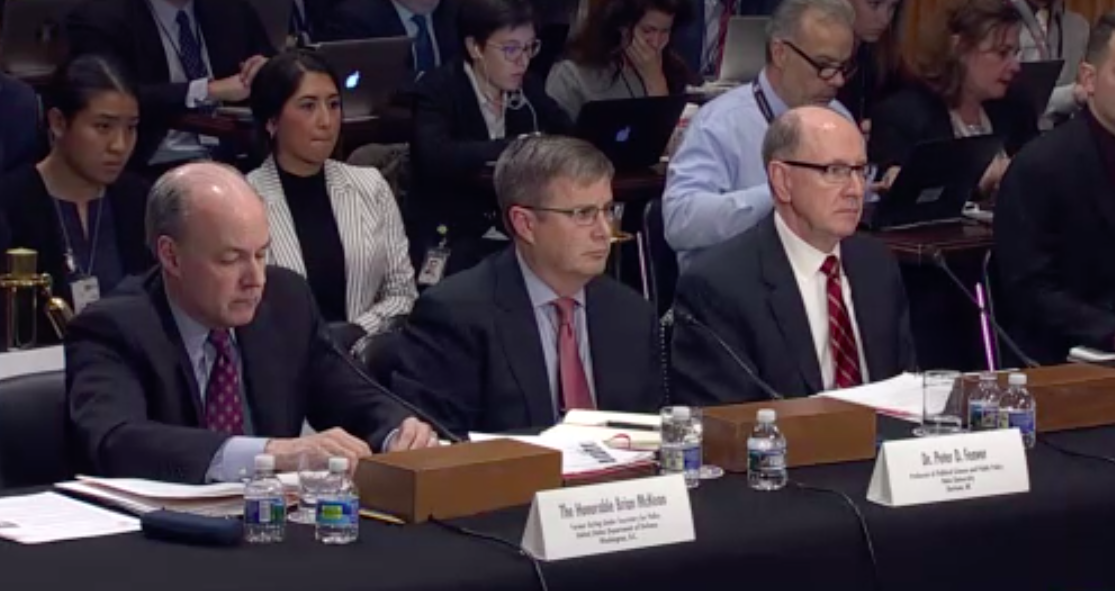
Brian McKeon (left), Peter Feaver (center), and retired USAF Gen. Robert Kehler testify on potential changes to the US nuclear command and control enterprise before the Senate Foreign Relations Committee on Nov. 14, 2017. Screenshot photo from C-Span video.
Retired USAF Gen. Robert Kehler, former commander of US Strategic Command, urged Congress on Tuesday to be cautious in considering potential changes to the nation’s nuclear command and control (C2) protocols—that is, the decision-making procedures around the potential launch of a nuclear weapon.
“I want to urge caution as you consider these matters,” Kehler told the Senate Foreign Relations Committee. “Changes or conflicting signals can have profound implications for deterrence, for extended deterrence, and for the confidence of the men and the women in the nuclear forces.”
Kehler’s advice came as the committee began what chairman Sen. Bob Corker (R-Tenn.) said would be a series of hearings to consider, for the first time in more than 40 years, whether “the authority and the process for the use of nuclear weapons” by the US military requires updating. The Committee’s review was motivated by the complexity of “today’s challenges,” ranking member Sen. Ben Cardin (D-Md.) said, and particularly by the threat of “a nuclear conflict that springs from an escalating conflict with smaller nuclear forces such as North Korea.”
On the question of military options for eliminating the nuclear threat from Pyongyang, Cardin referenced the Department of Defense assessment that “the use of conventional weapons could lead to an extreme number of casualties in Japan or in South Korea,” and he expressed concern that “there may be a discussion about whether a nuclear-first strike could prevent that from occurring.” In this regard, Cardin said, the hearing was “not a hypothetical discussion,” but driven by clear changes in the strategic threat environment, as well as the worry that a president could take on the responsibility to order a nuclear-first strike unadvisedly.
In response to this concern, the three witnesses agreed that “the president alone could not effect the strike,” as Peter Feaver, professor of political science and public policy at Duke University, told the committee. “He would require lots of people cooperating with him to make the strike happen, and they’d be asking the questions that would slow down that process.”
Brian McKeon, former acting under secretary of defense for policy, agreed. “In the absence of an attack or an imminent attack, the Constitution requires [the President] to come to Congress and get that authority,” he told the committee. McKeon clarified, however, that in the case of an attack on the US, “the President would have that authority … to defend the country, and there’s no distinction between his authority to use conventional or nuclear weapons in response to such an attack.”
In the case of North Korea, the question of authorization for war is complex. Feaver encouraged the committee to invite legal advisors to testify specifically on war powers on the Korean peninsula because, he said, “we are still under armed hostilities, just in an armistice, from the first Korean War.” (See Keeping Peace in Korea from the November 2016 issue of Air Force Magazine.) He also said these authorities could “provide some legal basis for actions” against North Korea on the part of the President without congressional approval.
Other senators expressed concern about current nuclear C2 policy in relation to the behavior of President Donald Trump. “We are concerned,” said Sen. Chris Murphy (D-Conn.), “that the President of the United States is so unstable, is so volatile, has a decision-making process that is so quixotic that he might order a nuclear weapons strike that is wildly out of step with US national security interests.”
Sen. Jeanne Shaheen (D-N.H.) also expressed concern about the strategic deterrence impact of Trump’s social media activity. “I want the President to act in a way that acknowledges input from a lot of experts, and not to act based on a Twitter post,” she said. McKeon acknowledged the risk of miscalculation is real. “The statements the President makes through his Twitter account,” he said, “no doubt cause concern and confusion on the other side of the Pacific.”
Despite the worries of some about Trump, Kehler sought to reassure the committee that “for nuclear decision-making at the highest level, it’s a consultative process.” He said that “a presidential order to employ US nuclear weapons must be legal,” and that there has always been a human element at the core of the nuclear C2 structure for this very reason. “The basic legal principles of military necessity, distinction, and proportionality apply to nuclear weapons just as they do to every other weapon,” Kehler said. Even when it comes to a nuclear launch, “the United States military doesn’t blindly follow orders.”
Despite his worries, McKeon also cautioned the senators on making any nuclear C2 changes. “If we were to change the decision-making process in some way because of a distrust of this President, I think that would be an unfortunate precedent for future presidents,” he said.
The witnesses agreed, however, that updates to the nuclear C2 systems are worth pursuing because “it has suffered from a lack of investment for too long,” according to McKeon.
“These are very expensive,” Feaver warned the committee, but he insisted that “it’s an investment worth making” precisely because “an accident or unauthorized use would be so catastrophic.”
Otherwise, senators should stick to consideration of reforms that “maximize the opportunity for the human element to mitigate risks by maximizing time for deliberation and assessment,” Feaver said. “For decades now it’s been technically possible to build a nuclear C2 system that would eliminate the human element altogether,” he told the committee. But “every generation of strategic leaders has understood that such a system would be foolhardy in the extreme.”